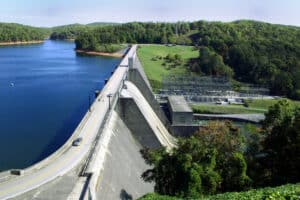
Top 3 Things to Know About the Walters Dam on the Pigeon River
For those who have joined us for our popular Upper River Trip on the river, you may remember that the water levels are dependent upon natural conditions before Memorial Day weekend and after Labor Day weekend. However, during the summer season, there are scheduled whitewater level releases from the Walters Dam to control the flow of the river. If you’ve ever wondered about the purpose and history of this dam, we’re here to shed a little light on the subject! Here are the top 3 things to know about the Walters Dam on the Pigeon River:
1. Walters Dam Periodically Releases Water
 Our white water rafting operation is situated directly on the Pigeon River, which extends from western North Carolina into East Tennessee. A hydroelectric dam, known as the Walters Dam, is just about 6 miles south of our river outpost. Since this plant generates hydroelectric power, it periodically releases water into the river and helps power most of the thrilling rapids that you experience on our trips! Since the Walters Dam has scheduled releases during the summer months, you can count on plenty of class III and IV rapids on our Upper Pigeon River Rafting Trip! When the water is not released, the river is essentially “turned off” and dependent upon natural conditions. However, this can also be an exciting time to join our trips because the rapids are more unpredictable!
Our white water rafting operation is situated directly on the Pigeon River, which extends from western North Carolina into East Tennessee. A hydroelectric dam, known as the Walters Dam, is just about 6 miles south of our river outpost. Since this plant generates hydroelectric power, it periodically releases water into the river and helps power most of the thrilling rapids that you experience on our trips! Since the Walters Dam has scheduled releases during the summer months, you can count on plenty of class III and IV rapids on our Upper Pigeon River Rafting Trip! When the water is not released, the river is essentially “turned off” and dependent upon natural conditions. However, this can also be an exciting time to join our trips because the rapids are more unpredictable!
2. Construction of the Walters Dam
Construction of the Walters Dam was started in 1927 by the Carolina Power and Light Company, and it was completed by their affiliate (Phoenix Electric Company) in 1930. The concrete arch dam stands 180 feet high and 800 feet long, and it is located just west of Interstate 40. The brick powerplant is actually 6.2 miles from the dam near the Tennessee/North Carolina border, and a tunnel stretches the entire distance from the dam to the power plant! Walters Dam is now owned and operated by Duke Energy as an active hydroelectric facility, and it was designated as a North Carolina Historic Civil Engineering Landmark in 1980.
3. How a Hydroelectric Power Dam Works
 A hydroelectric dam, such as the Walters Dam, is a major component of a hydroelectric facility. In addition to controlling the flow of the river, the dam helps to convert the potential and kinetic energy of water into electrical energy by the use of a turbine and generator at the power plant. The amount of electricity that can be generated at the plant is determined by two factors, the head (how far the water drops) and the flow (the distance from the highest level of the water to the point where it goes through the power-producing turbine). One of the biggest benefits of the plant is that it can store energy, in the form of water, in a reservoir and release it when needed for energy production.
A hydroelectric dam, such as the Walters Dam, is a major component of a hydroelectric facility. In addition to controlling the flow of the river, the dam helps to convert the potential and kinetic energy of water into electrical energy by the use of a turbine and generator at the power plant. The amount of electricity that can be generated at the plant is determined by two factors, the head (how far the water drops) and the flow (the distance from the highest level of the water to the point where it goes through the power-producing turbine). One of the biggest benefits of the plant is that it can store energy, in the form of water, in a reservoir and release it when needed for energy production.
Now that you know all about the Walters Dam and how it helps create some thrilling rapids, check out our white water rafting adventures on the Pigeon River to be one of the first guests to book for the upcoming season! We look forward to seeing you in the spring!







